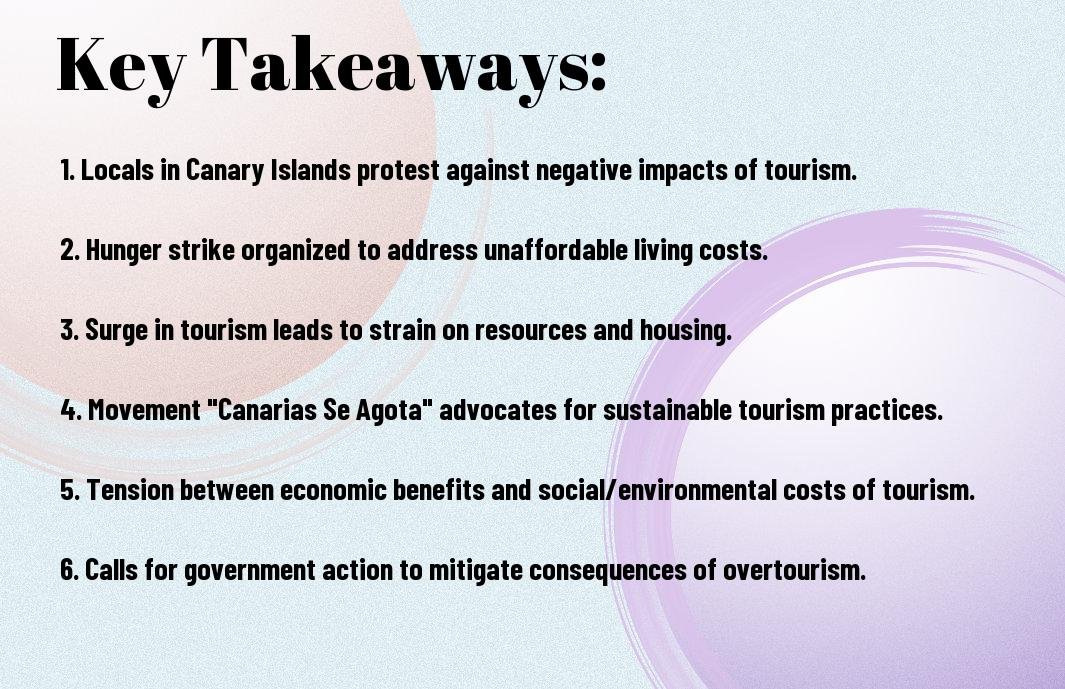
There’s no denying the allure of the Canary Islands as a premier vacation destination, attracting millions of tourists yearly with its picturesque landscapes and year-round sunshine. However, beneath the surface lies a growing crisis fueled by the negative impacts of mass tourism. Locals in the archipelago have taken a stand against the unsustainable practices that have led to skyrocketing rental prices, environmental degradation, and a diminishing quality of life for residents.


The Rise of Tourism in the Canary Islands
Historical Perspectives on Tourism Development
To understand the current state of tourism in the Canary Islands, it is necessary to look back at its historical development. The island’s popularity as a tourist destination has surged over the past decade, with the number of visitors increasing by nearly five million annually. This growth has brought economic prosperity and challenges as the strain on local resources and housing has become more evident. Amidst escalating rental prices and environmental concerns, some locals have resorted to living in their cars, highlighting the urgent need for sustainable tourism practices.
Current Tourism Trends and Statistics
Tourism in the Canary Islands has reached unprecedented levels, with the movement “Canarias Se Agota” (The Canary Islands are Exhausted) organizing protests, including a hunger strike, to raise awareness of the negative impacts of mass tourism. This growing movement underscores the tension between tourism’s economic benefits and social and environmental costs. Despite the challenges, the Canary Islands attract millions of visitors yearly, contributing significantly to the local economy.
Statistics: The surge in tourism has led to a sharp increase in rental prices and strains on local resources, prompting a call for sustainable tourism practices. The movement “Canarias Se Agota” calls for government intervention to mitigate the consequences of overtourism, striking a balance between economic prosperity and the well-being of the resident population.
The Economic Impact of Tourism
Contribution to the Local Economy
Any discussion on the Canary Islands would be incomplete without acknowledging the substantial economic contribution of tourism to the region. Over the past decade, the archipelago has witnessed a surge in tourism, with nearly five million visitors annually. This influx of tourists has boosted the local economy and created significant revenue streams for businesses and individuals in the hospitality and service sectors. The economic benefits of tourism are evident in increased job opportunities, higher demand for goods and services, and a flourishing real estate market driven by the tourism boom.
Employment Opportunities in the Tourism Sector
With the exponential growth of tourism in the Canary Islands, the sector has become a vital source of employment for locals. The influx of visitors has led to a surge in job opportunities in hotels, restaurants, tour agencies, and other related industries. According to data, tourism accounts for a significant portion of the local economy, providing livelihoods for a large population segment. The industry’s expansion has created jobs and offered career growth and development pathways in the hospitality and service sectors.
Understanding the importance of tourism as a driver of economic growth is crucial for policymakers and stakeholders in the Canary Islands. While tourism bolsters the economy and creates employment opportunities, it is essential to strike a balance between reaping the benefits of tourism and mitigating its social and environmental impacts on the local community. By implementing sustainable tourism practices and actively addressing issues such as affordability, resource strain, and housing shortages, the Canary Islands can ensure the long-term prosperity of both its economy and residents.
Social Consequences of Tourism Expansion
Housing Market Pressures and Local Displacement
The rapid expansion of tourism in the Canary Islands has led to a surge in visitors, putting immense pressure on the local housing market. As a result, residents face rising rental prices, forcing some to resort to extreme measures such as living in their cars. The strain on housing resources exacerbates the issue of local displacement, as residents are being priced out of their communities due to the increasing demand from tourists.
Alteration of Community Life and Local Culture
Local communities in the Canary Islands are experiencing a profound shift in their way of life and cultural identity due to the overwhelming impact of mass tourism. The influx of tourists has altered the traditional practices and customs of the local population, leading to a decline in authentic local experiences. As a result, there is a growing concern among residents that their unique way of life is being diluted in favor of catering to the preferences of tourists, which could ultimately erode the sense of community and belonging.
Balancing tourism’s economic benefits and preserving the local culture and community is essential. While tourism plays a significant role in the Canary Islands’ economy, it is imperative to implement sustainable practices that prioritize the local population’s well-being and prevent further social and cultural disruptions.
The Environmental Impact of Mass Tourism
Strain on Natural Resources and Biodiversity
Despite the economic benefits brought by mass tourism, significant challenges arise from the strain on natural resources and biodiversity in popular destinations like the Canary Islands. Over the past decade, tourism in the archipelago has surged, increasing by nearly five million visitors annually. This surge has put immense pressure on the island’s fragile ecosystems, destroying habitat and endangering native flora and fauna.
Pollution and Waste Management Challenges
One of the critical concerns stemming from mass tourism is the pollution and waste management challenges it presents. The increase in visitor numbers has resulted in a spike in trash generation, placing a heavy burden on local waste management systems. Some locals have even had to live in their cars due to the escalating rental prices driven by the tourism boom, exacerbating the waste management issue.
Resources dedicated to waste disposal and recycling are being stretched thin, leading to overflowing landfills and littered beaches. Efforts to manage and mitigate this waste problem are vital in preserving the natural beauty and ecological integrity of the Canary Islands.
Environmental sustainability must be a top priority in the face of growing tourism pressures. Implementing measures to reduce waste, promote recycling, and protect sensitive habitats is crucial in ensuring the long-term health and prosperity of the Canary Islands.
The Protest Movement: “Canarias Se Agota”
Origins and Rationale Behind the Movement
Once again, the Canary Islands find themselves at the center of a contentious debate over the impacts of mass tourism on their society and environment. The movement, known as “Canarias Se Agota” (The Canary Islands are Exhausted), has arisen as a response to the rapid surge in tourism that has strained local resources and driven up housing costs in the archipelago. With nearly five million additional visitors annually over the past decade, residents have been pushed to drastic measures, including living in their cars due to the escalating rental prices fueled by the tourism boom.
Forms of Protest: From Hunger Strike to Demonstrations
The movement “Canarias Se Agota” has organized protests ranging from a hunger strike to human chain demonstrations to vocalize their demands for sustainable tourism practices that prioritize the local population’s well-being. At the forefront of these actions is a hunger strike initiated by locals to draw attention to the pressing issue. This unique form of protest highlights the desperation and urgency felt by residents who see their way of life threatened by the unchecked growth of tourism in the Canary Islands.
Solutions and Sustainable Tourism Practices
Governmental Policies and Intervention Strategies
Many governmental policies and intervention strategies are being considered in response to the negative impacts of mass tourism on the Canary Islands. The surge in tourism, with nearly five million visitors annually, has prompted authorities to take action to ensure the local population’s well-being. The government is exploring measures to control the escalating rental prices and strain on local resources caused by the tourism boom. Efforts are underway to strike a balance between the economic benefits of tourism and the social and environmental costs.
Promoting Responsible Tourism and Community Involvement
Community involvement is crucial in promoting responsible tourism in the Canary Islands. The “Canarias Se Agota” movement is a testament to the power of residents coming together to advocate for sustainable practices in the tourism industry. Human chains and hunger strikes are symbolic gestures and serve as a call to action for the government to prioritize the local community’s well-being. Involving residents in decision-making processes and encouraging responsible tourist behavior can help mitigate the consequences of over-tourism while preserving the islands’ allure.
Conclusion
Considering all points, the protests and hunger strikes initiated by locals in the Canary Islands shed light on the complex relationship between mass tourism and the well-being of resident populations. The rapid growth of tourism in the archipelago has brought economic benefits and significant social and environmental challenges. The movement “Canarias Se Agota” is a poignant reminder of the importance of sustainable tourism practices that prioritize the needs of local communities and the preservation of natural resources.
The government and stakeholders in the tourism industry must heed residents’ calls for action and implement measures to alleviate the negative impacts of over-tourism. Finding a balance between economic prosperity and social and environmental sustainability is crucial for the long-term viability of the Canary Islands as a tourism destination. By working together towards a more sustainable tourism model, we can ensure that the islands continue to thrive while safeguarding the quality of life for those who call them home.
FAQ
Q: What is the ‘Canarias Se Agota’ movement?
A: The ‘Canarias Se Agota’ movement is a protest movement in the Canary Islands that addresses the negative impacts of mass tourism on the local population and environment.
Q: What are some of the issues that locals in the Canary Islands face due to mass tourism?
A: Locals in the Canary Islands face affordable housing shortages, environmental damage, and a high cost of living due to increased regional tourism.
Q: How has tourism in the Canary Islands changed over the past decade?
A: Tourism in the Canary Islands has surged over the past decade, with nearly five million more visitors annually, putting a strain on local resources and infrastructure.
Q: What actions has the ‘Canarias Se Agota’ movement taken to protest against the negative impacts of mass tourism?
A: The ‘Canarias Se Agota’ movement has organized a hunger strike, demonstrations such as human chains, and calls for sustainable tourism practices from the government.
Q: What is the critical challenge in addressing the issues caused by mass tourism in the Canary Islands?
A: The critical challenge is to balance the economic benefits of tourism and the social and environmental costs to preserve the islands’ allure without sacrificing the quality of life for their inhabitants.



